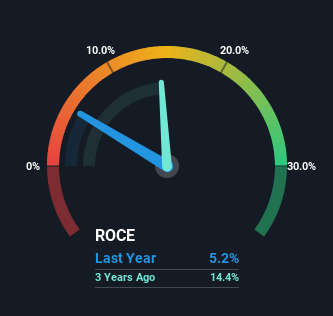- Hong Kong
- /
- Specialty Stores
- /
- SEHK:6909
Returns On Capital Signal Tricky Times Ahead For BetterLife Holding (HKG:6909)

If you're looking for a multi-bagger, there's a few things to keep an eye out for. Ideally, a business will show two trends; firstly a growing return on capital employed (ROCE) and secondly, an increasing amount of capital employed. Basically this means that a company has profitable initiatives that it can continue to reinvest in, which is a trait of a compounding machine. However, after investigating BetterLife Holding (HKG:6909), we don't think it's current trends fit the mold of a multi-bagger.
What Is Return On Capital Employed (ROCE)?
For those who don't know, ROCE is a measure of a company's yearly pre-tax profit (its return), relative to the capital employed in the business. Analysts use this formula to calculate it for BetterLife Holding:
Return on Capital Employed = Earnings Before Interest and Tax (EBIT) ÷ (Total Assets - Current Liabilities)
0.052 = CN¥181m ÷ (CN¥4.7b - CN¥1.2b) (Based on the trailing twelve months to December 2023).
Therefore, BetterLife Holding has an ROCE of 5.2%. In absolute terms, that's a low return and it also under-performs the Specialty Retail industry average of 9.9%.
View our latest analysis for BetterLife Holding

While the past is not representative of the future, it can be helpful to know how a company has performed historically, which is why we have this chart above. If you want to delve into the historical earnings , check out these free graphs detailing revenue and cash flow performance of BetterLife Holding.
How Are Returns Trending?
On the surface, the trend of ROCE at BetterLife Holding doesn't inspire confidence. To be more specific, ROCE has fallen from 28% over the last five years. Meanwhile, the business is utilizing more capital but this hasn't moved the needle much in terms of sales in the past 12 months, so this could reflect longer term investments. It may take some time before the company starts to see any change in earnings from these investments.
On a side note, BetterLife Holding has done well to pay down its current liabilities to 26% of total assets. So we could link some of this to the decrease in ROCE. What's more, this can reduce some aspects of risk to the business because now the company's suppliers or short-term creditors are funding less of its operations. Some would claim this reduces the business' efficiency at generating ROCE since it is now funding more of the operations with its own money.
What We Can Learn From BetterLife Holding's ROCE
Bringing it all together, while we're somewhat encouraged by BetterLife Holding's reinvestment in its own business, we're aware that returns are shrinking. It seems that investors have little hope of these trends getting any better and that may have partly contributed to the stock collapsing 83% in the last year. All in all, the inherent trends aren't typical of multi-baggers, so if that's what you're after, we think you might have more luck elsewhere.
One more thing: We've identified 5 warning signs with BetterLife Holding (at least 2 which make us uncomfortable) , and understanding these would certainly be useful.
While BetterLife Holding isn't earning the highest return, check out this free list of companies that are earning high returns on equity with solid balance sheets.
Valuation is complex, but we're here to simplify it.
Discover if BetterLife Holding might be undervalued or overvalued with our detailed analysis, featuring fair value estimates, potential risks, dividends, insider trades, and its financial condition.
Access Free AnalysisHave feedback on this article? Concerned about the content? Get in touch with us directly. Alternatively, email editorial-team (at) simplywallst.com.
This article by Simply Wall St is general in nature. We provide commentary based on historical data and analyst forecasts only using an unbiased methodology and our articles are not intended to be financial advice. It does not constitute a recommendation to buy or sell any stock, and does not take account of your objectives, or your financial situation. We aim to bring you long-term focused analysis driven by fundamental data. Note that our analysis may not factor in the latest price-sensitive company announcements or qualitative material. Simply Wall St has no position in any stocks mentioned.
About SEHK:6909
BetterLife Holding
Provides automobile dealership services with a focus on luxury and ultra-luxury brands in the People’s Republic of China.
Excellent balance sheet and good value.
Market Insights
Community Narratives



